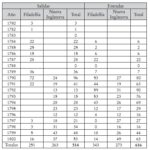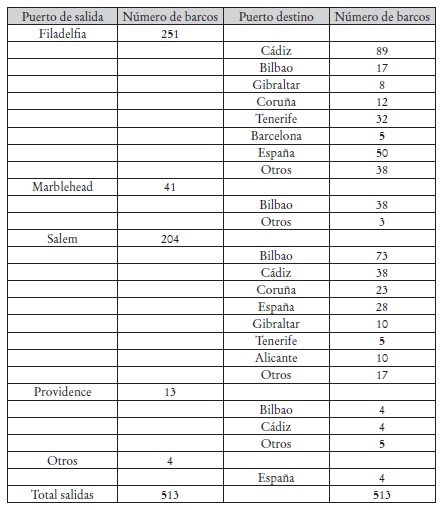
The 1790s provided the newly created republic of the United States with a commercial impetus during the early years of the 19th century that would contribute to the development of the new nation. Independence brought an end to the policies of exclusivity and the opening of colonial ports, particularly Spanish and French ones. Contrary to what might have been thought, trade between the Thirteen Colonies and ports on the Iberian Peninsula did not come to a standstill; ports such as Philadelphia intensified their traffic with Cadiz and Lisbon. Navigation, especially to Cadiz and through the Strait of Gibraltar, was not without risk. Since Independence, the US government tried to neutralise the activity of Barbary corsairs against its commerce by disbursing money. In this regard, American captains interested in the trade arrived in Iberian ports. Between 1780-1800, 765 ships left US ports for the Iberian Peninsula and another 1,312 touched a Portuguese or Spanish port before sailing back across the Atlantic. The close-up reveals a considerable difference between the number of ships that left (514) and those that returned (616), a circumstance that could be due to nature itself. This table reveals that the annual movement of traffic was within the growth parameters that characterised American shipping in the late 1800s. However, not all American ports had the same relevance in traffic with Spain, as specialisation in the export of certain goods conditioned the traffic pattern. Spanish demand was centred on cereals, flour, fish and wood, therefore, the ports of Philadelphia and Salem were those which concentrated the greatest number of departures, 49.5% and 39% respectively. In the case of inbound traffic, the situation changes, with 62% of the ships going to the port of Philadelphia and only 17% returning to Marblehead. The distribution of traffic was fairly homogeneous: between 1780-1800 the majority of American ships went to Cadiz and Bilbao (49.7%), although with substantial differences in terms of the origin of the vessels.
Collection: Statistics
Project: 2. Social and economic impact of technological revolutions in Europe., 9. Travels and travelers: economic, social and cultural connections.
Chronology: XVIII, XIX
Scope: Secondary Education, Baccalaureate, University
Link: https://revistas.usal.es/index.php/Studia_Historica/article/view/shhmo2020421165193/22499
Resource type: Statistics
Format: Table
Source: Carrasco González, Guadalupe, «Vino, sal y pasas por harina pescado y duelas: el tráfico marítimo comercial estadounidense con España a finales del siglo XVIII (1780–1800). Una primera aproximación, Studia Historica, Historia Moderna, 42, 1 (2020), pp. 165–193.
Language: Spanish
Date: 2021
Owner: Álvaro Romero González (Modernalia)
Copyright: © Guadalupe González Carrasco © Revista Studia Historica, Historia Moderna
Abstract: Ship movements between Spain and the United States in the late 18th century
Image
Tags







